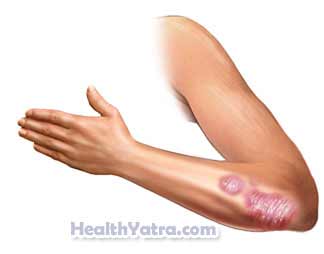সংজ্ঞা
Phototherapy uses lightwaves to treat certain skin conditions. The skin is exposed to an ultraviolet (UV) light for a set amount of time. Phototherapy uses a man-made source of UV light but UV light also comes from the sun.
পদ্ধতির কারণ
UV light shuts down রোগ প্রতিরোধক ব্যবস্থাপনা cells in the skin. It can help in skin conditions that are caused by an overreaction of the immune system. Skin conditions that are treated with phototherapy include:
- Psoriasis —a skin disorder that causes red, silvery, scaly patches on the skin
- Atopic dermatitis —eczema (itchy, red skin condition) or dermatitis due to allergies
- Mycosis fugoides (cutaneous T-cell lymphoma)—a type of lymphoma confined to the skin
- Vitiligo —a skin disorder where normal skin pigment is lost due to destruction of pigment-producing cells by the immune system

সম্ভাব্য জটিলতা
The UV lights may negatively affect your skin in a number of ways, including:
- Skin conditions could temporarily worsen
- Itchy চামড়া
- Red skin due to exposure to the lights
- Burning of the skin
PUVA treatment may also cause:
- Nausea (if you took the psoralen pills)
- Burning skin
- Cataracts (lens of eye becomes cloudy, affecting vision)
- মাথাব্যথা
- ক্লান্তি
If you have received a great number of phototherapy treatments, you may be at risk for:
- Premature aging of the skin, such as wrinkling and dryness
- Age spots or freckles may appear
জটিলতার ঝুঁকি বাড়াতে পারে এমন কারণগুলির মধ্যে রয়েছে:
- Allergy to sunlight
- Pregnancy or nursing
- Medical conditions (such as skin cancer or lupus) that require you to avoid the sun
- History of skin cancer
- Liver disease (phototherapy may increase medicine levels in the blood)
কি আশা করা যায়
পদ্ধতির আগে
You will be asked to remove any clothes that cover the skin being treated. Areas that do not চিকিৎসা প্রয়োজন should be covered and protected as much as possible. Some safety steps include:
- Sunscreen to protect your neck, lips, and the backs of your hands.
- Special glasses or goggles to protect your eyes from UV light.
- Cover for genitals in men.
- Sunscreen for nipples and areola in women.
Make sure to inform your doctor about any medicine that you are currently taking. Some medicines, including over-the-counter medicine, can increase the risk of side effects.
পদ্ধতির বর্ণনা
Types of phototherapy include:
- Broad band UVB—Uses UV light, type B. It cannot be used in areas where there are skin folds.
- Narrow band UVB (nbUVB)—Uses a narrower range of UVB wavelengths. It can reach more specific areas, even skin folds.
- PUVA—This treatment includes a medicine called psoralen taken before treatment. It makes your skin more sensitive to the UV light. Psoralen can be taken as a pill or applied to the skin.
- Lasers—An excimer laser emits a UV light. It can be directed at specific areas of the skin.
Treatment over a large area may be treated in a treatment unit. You can stand in this unit during treatment. Smaller areas may be treated with smaller units. A laser treatment will use a laser light that is focused on the specific area.
কতক্ষণ এটা লাগবে?
The first treatment is usually very short, even a few seconds. Your phototherapy sessions will vary in length. It will depend on your skin type and the strength of the light chosen by your doctor. Treatments rarely last longer than a few minutes.
Treatment for skin conditions generally requires several treatments each week. The length of treatment will depend the type of phototherapy:
- Broad band therapy requires approximately 3-5 treatments each week.
- Narrow band therapy requires fewer treatments (2-3 treatments) each week.
- PUVA treatments generally require about 25 treatments over a 2-3 month period.
- Laser treatments are usually given twice a week and fewer sessions are required to clear the skin.
Treatments will continue until your skin is clear. Sometimes, occasional maintenance treatments are needed. The maintenance sessions can usually be done right in your doctor’s office, or even with a home UV light unit.
এটা আঘাত করবে?
You may feel a warm sensation on your skin, similar to a mild sunburn. Your doctor can recommend medication if you have discomfort after treatment.
পোস্ট-প্রক্রিয়া যত্ন
It is important to avoid natural sunlight when you are receiving UV light treatment:
- Clothing and sunscreen should be used when outdoors. They will help you avoid overexposure to UV light.
- There is an even bigger risk of sunburn after PUVA treatment. This is due to increased sensitivity from the psoralen.
- It is important to protect your eyes from sunlight exposure for the next 24 hours. This will help you to avoid cataracts, a clouding of the eye, after PUVA treatment.
- Antihistamines and other medicine may be given to ease the itching.
Your doctor should regularly examine your skin for skin cancer. UV light exposure from sunlight causes skin cancer. Long term PUVA treatment can also increase the ত্বক ক্যান্সারের ঝুঁকি. No studies have found a direct link from nb UVB phototherapy to skin cancer.
আপনার ডাক্তারের নির্দেশাবলী অনুসরণ করতে ভুলবেন না।
আপনার ডাক্তারকে কল করুন
বাড়িতে পৌঁছানোর পরে, নিম্নলিখিতগুলির মধ্যে যে কোনও একটি ঘটলে আপনার ডাক্তারের সাথে যোগাযোগ করুন:
- জ্বর এবং ঠাণ্ডা সহ সংক্রমণের লক্ষণ
- Redness around the ত্বকের ক্ষত or any discharge
- Severe skin burning, pain, or blistering
- Side effects you experienced due to the treatment continue or worsen
- Development of new or surprising symptoms
জরুরী পরিস্থিতিতে, অবিলম্বে চিকিৎসা সহায়তার জন্য কল করুন।
